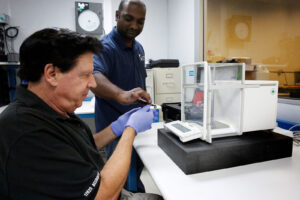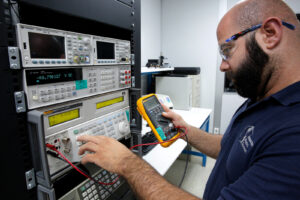Pipeline networks are the lifelines of modern infrastructure, delivering critical resources such as oil, gas, and water across vast distances. Ensuring the accuracy, safety, and efficiency of these systems is not just good practice—it’s essential. At the heart of effective pipeline oversight lies ultrasonic flow calibration, a technology-driven solution that has become indispensable in pipeline monitoring and leak detection.
Understanding Ultrasonic Flow Calibration
Ultrasonic flow meters measure fluid velocity using ultrasonic signals. When properly calibrated, these instruments deliver high-precision measurements that empower operators to maintain flow integrity, spot irregularities, and prevent costly or catastrophic failures. Calibration ensures that these meters maintain their original accuracy standards over time and under varying operating conditions.
In ultrasonic flow calibration, reference standards—typically traceable to national or international measurement institutes—are used to verify and adjust the ultrasonic meter’s readings. This process compensates for wear, environmental conditions, and drift, making it a vital tool for both compliance and performance optimization.
The Critical Role of Calibration in Pipeline Monitoring
Pipeline operators face significant challenges when trying to track flow rates and maintain pipeline integrity. From subtle flow variations to large-scale leaks, even minor measurement discrepancies can lead to misallocation, revenue loss, and environmental hazards. This is where ultrasonic flow calibration becomes invaluable.
Improved Flow Accuracy
Precise calibration eliminates uncertainties and ensures that flow data reflects real-world conditions. By minimizing measurement error, we can detect anomalies in flow rate that might indicate blockages, degradation, or pipeline deformation. With real-time data aligned with actual volume transfer, operators gain the ability to fine-tune operations with confidence.
Early Leak Detection
Leaks can develop over time, and traditional monitoring techniques often miss early signs. Calibrated ultrasonic flow meters can pick up on subtle changes in flow rate or velocity that point to leakage. Detecting leaks early helps in reducing downtime, avoiding environmental penalties, and minimizing repair costs.
Operational Efficiency and Asset Longevity
When meters are precisely calibrated, pipeline operators avoid overcompensation or overpressurization, both of which contribute to premature wear. Consistent ultrasonic calibration supports predictive maintenance programs, extending the lifespan of infrastructure and improving the return on investment.
Enhanced Leak Detection with Ultrasonic Technology
Leak detection is a mission-critical component of pipeline operations. Undetected leaks can cause substantial environmental damage, regulatory fines, and public safety issues. Ultrasonic technology, particularly when supported by rigorous calibration, delivers a powerful solution.
Real-Time Monitoring
Ultrasonic flow meters can be installed permanently for continuous, real-time flow analysis. Their non-intrusive design avoids flow disruption, and their capability to measure bidirectional flow makes them ideal for complex pipeline systems. Through calibrated accuracy, deviations from expected patterns trigger alerts—often before visual inspections would notice anything.
Integration with SCADA and IoT Systems
Calibrated ultrasonic flow meters are fully compatible with modern SCADA (Supervisory Control and Data Acquisition) and IoT platforms. This integration allows for automated leak detection and flow optimization. When the calibration process ensures trustworthy data input, these systems function as high-performance monitoring hubs, instantly notifying technicians of deviations from norms.
Quantifying and Localizing Leaks
Advanced ultrasonic solutions not only detect that a leak exists—they help determine where and how much is leaking. Calibrated meters detect asymmetrical flow patterns and velocity shifts along the pipeline, enabling operators to zero in on specific pipeline segments. This targeted information shortens response time and reduces repair overhead.
Advantages Over Traditional Flow Monitoring Methods
Compared to legacy methods like differential pressure or turbine meters, ultrasonic flow meters—when accurately calibrated—offer a host of advantages.
Non-Intrusive and Low Maintenance
Unlike mechanical meters that suffer from wear and tear, ultrasonic units have no moving parts. This reduces the need for frequent repairs and allows them to operate in harsh conditions, including high-pressure or corrosive environments.
Wide Range and Bidirectional Capability
Calibrated ultrasonic meters perform exceptionally well across varied flow rates and directions. This adaptability is essential in systems where flow reversals or variable throughput occurs. Unlike other meters that may fail to register reverse flow accurately, ultrasonic technology ensures full-spectrum accountability.
Minimal Pressure Drop
Since ultrasonic meters do not obstruct the flow path, they maintain optimal pressure levels throughout the system. This efficiency reduces energy consumption and supports sustainable operations.
Best Practices in Ultrasonic Flow Calibration
To fully leverage ultrasonic calibration for pipeline monitoring and leak detection, it’s vital to implement industry best practices.
Regular Calibration Intervals
Calibration is not a one-time task. We recommend performing calibration at scheduled intervals based on operational load, environmental conditions, and regulatory requirements. This ensures meter reliability over time and aligns with ISO/IEC 17025 standards.
Use of Accredited Calibration Labs
Working with ISO-accredited laboratories ensures that calibration procedures are conducted using traceable standards and validated methodologies. This instills confidence in the accuracy of the data used for operational decisions.
On-Site vs. Laboratory Calibration
In-field calibration allows for minimal system disruption, especially useful for large-scale pipelines. However, for high-precision requirements, laboratory calibration in a controlled environment provides an even higher level of confidence.
Calibration Under Operating Conditions
Whenever possible, meters should be calibrated under actual flow conditions to replicate real-world performance. This approach accounts for variables such as fluid viscosity, temperature, and pressure that impact measurement accuracy.
Ultrasonic Flow Calibration in Industry Applications
Ultrasonic calibration is not limited to any one industry. It plays a vital role in:
- Oil and Gas Pipelines: For custody transfer, allocation metering, and regulatory compliance.
- Water and Wastewater: In distribution systems to monitor consumption and detect infrastructure leaks.
- Chemical Processing: To ensure proper dosing and safe transport of hazardous materials.
- Power Generation: Especially in steam or cooling water lines where measurement accuracy is essential.
Conclusion: Elevating Pipeline Intelligence Through Calibration
The evolution of pipeline monitoring and leak detection hinges on ultrasonic flow calibration. It bridges the gap between raw data and actionable insight, enabling operators to optimize system performance while minimizing risk. By investing in routine, high-quality calibration, industries not only comply with regulatory standards but also create a smarter, more resilient pipeline infrastructure.
In an era where operational efficiency and environmental stewardship are paramount, ultrasonic flow calibration is no longer optional—it’s essential.





